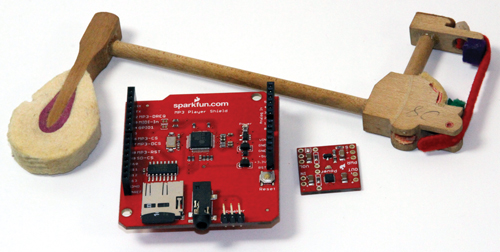Sound Off!
By Bryan Bergeron
My current favorite for playing sequences of MP3 sounds is the Sparkfun MP3 player shield for the Arduino ($60), together with their 1.4W class D audio amp ($8), shown in the accompanying figure. I included the mechanical striker (or hammer) from a 50 year old piano for a size comparison, as well as a reminder of how far we’ve come in the production and reproduction of sound.
The mechanical striker is quite a piece of craftsmanship — there are multiple layers of felt, chucks of cork, leather, and carefully glued joints. It’s a one-of-a-kind, and — together with the wires and other components in an all-mechanical piano — creates a rich tone that can’t be fully reproduced on consumer-grade electronics.
The MP3 shield with an accompanying amp, in contrast, are stamped out in the thousands. Furthermore, MP3 files downloaded from the Internet sound the same on every shield. Some of the subtleties may be missing in the audio playback, but most people don’t notice.
I like the shield as a sound-effects source because of the ease with which MP3 files — stored on the onboard Flash drive — can be accessed and played. For headphones, it’s simply plug-and-play. However, if you need to drive an amp that isn’t configured for the low impedance audio output available from the headphone jack, then a pair of the 1.4W audio amps are a necessity (one amp for mono output). It’s possible to connect the MP3 player to a different amp, but I’d rather not bother with the capacitors and resistors needed to condition the output of the player.
I’ve also used the shield/amp combination with a small surface transducer (also available from SparkFun) that can transform a table top or plastic box into a speaker. You’ll have to add a resistor to the amp to increase the output of the amp so it drives the surface transducer to full output.
When it comes to voice, it’s hard to beat the price/performance of the Emic 2 text-to-speech module from Grand Idea Studio/Parallax ($60). The Propellerbased board — which is only 1.23” x 1.5” — supports nine voice styles in both English and Spanish. It uses the DECtalk text-to-speech engine to provide dynamic control for pitch, rate, and emphasis.
Last but not least, you should consider the Veho 360 speaker available from Parallax ($15). The golf ball sized speaker provides 2.4W of output for up to eight hours. It recharges in about four hours through a standard USB cable. Trouble is, I’m going broke giving these things to my nieces, nephews, and coworkers. Not only do they provide a simple, compact output for the SparkFun MP3 player and the Emic 2, but they transform a diminutive iPod into a boom box with amazing bass response. They also double as Christmas tree ornaments — something to consider in December. NV

Comments

